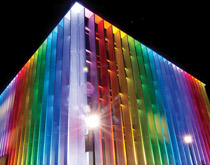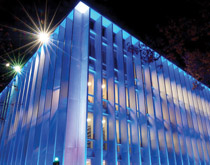With night approaching, the facade of Hunt Library resembles a patchwork quilt of windowed squares. A peek inside reveals tiny silhouettes that can be seen situated at tables or retrieving books from towering stacks. A pack of students plod toward the library with their game faces on, all weighted down by an albatross of textbooks and binders. With finals looming, it will be a long night ahead.

Suddenly, just as the library threatens to be swallowed by the dusk, its soul comes alive. Towering aluminum columns radiate a soothing blue hue, and waves of purple and silver roll over the effervescent facade. In that moment, the students' faces light up, too.
The luminosity was born out of a walk in the dark. One night two years ago, Bill Hunt strolled by the library and noticed it was unevenly lit. Students taking cell phone breaks outside couldn't even see the letters engraved on the marble canopy: Gift of Mr. and Mrs. Roy A. Hunt. Bill's late grandfather, Roy Hunt, donated $2.8 million for the construction of the library in 1960.
In 1888, Roy's father, Alfred, cofounded Aluminum Company of America, better known as Alcoa, with six other entrepreneurs in the parlor of his Pittsburgh home. A few years later, Alfred set off for Puerto Rico to serve as a cavalry captain in the Spanish-American War. He returned home with malaria in 1899 and died. Roy was 18.
After graduating from Yale, Roy went to work at Alcoa as a mill clerk, the start of a lifetime career with the company where he would eventually become president. Aluminum was Roy's world. His only diversion from work and family was the arts. Of course, his monument to learning had to be built with a certain material. "The reason the library ended up at Carnegie Mellon in the first place was because Pitt didn't want a modern aluminum building on campus," says Torrence "Tod" M. Hunt Jr., a grandson of Roy and Carnegie Mellon trustee.
Carnegie Tech welcomed the forward-thinking architecture, even with one stipulation. Roy's wife, Rachel, a bibliophile and avid gardener, wanted a botany institute on the top floor, which would include rare books from her collection. "My grandmother's touch is everywhere on the fifth floor," Tod says of the renowned Hunt Institute for Botanical Documentation. "There's an unusual mirror in the ladies' room. It's rose-colored, because my grandmother believed that once a woman reached the age of 50, she had the right to look at herself through rose-colored glass."
Bill thought of his grandmother as he strolled through campus two years ago, passing students making the trek to the campus' aluminum structure at the end of the Cut. The library, Bill thought, was missing her charm, which gave him an idea. Through a $200,000 gift from his family's nonprofit, The Hunt Foundation, Hunt Library would no longer be engulfed by darkness. Carnegie Mellon President Jared L. Cohon brought in Cindy Limauro and Chris Popowich of C & C Lighting, the architects of the Pausch Bridge's critically praised lighting design. Limauro, a professor of lighting design, enlisted the help of students to create an energy-efficient LED exterior lighting system with more than 16 million different color possibilities, producing a revolving library glow.

Would Roy approve? "I think my grandfather would be delighted to see the lights today," Tod says. "Of course, he wouldn't want them to be a distraction, because like most Pittsburghers of his day, he was a man of diligence."
No need to worry. It's easy to see that inside the illuminated aluminum, those silhouettes are hard at work.
—Sean Conboy (HS'08)



